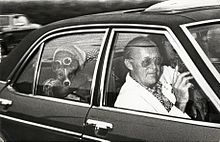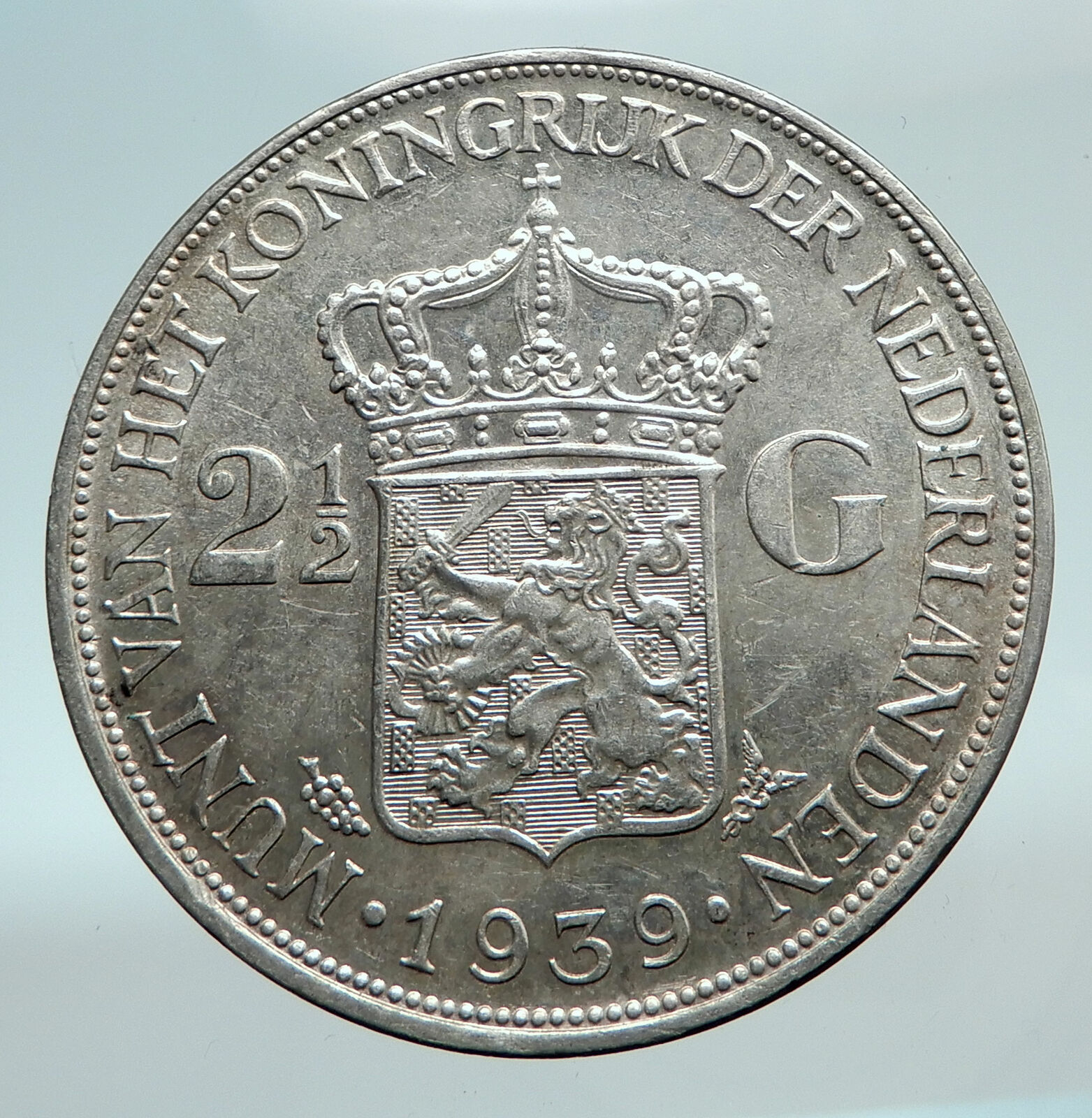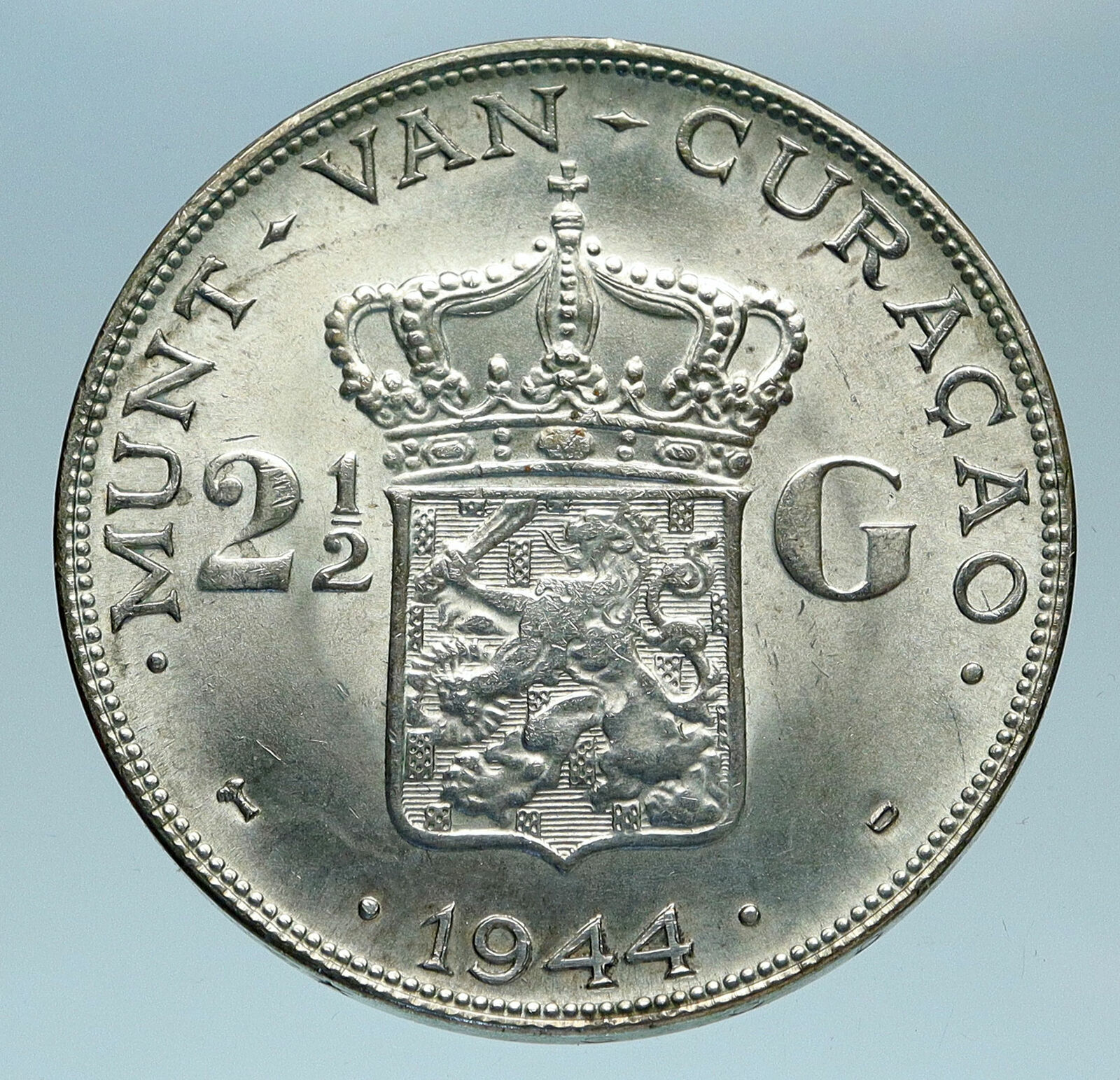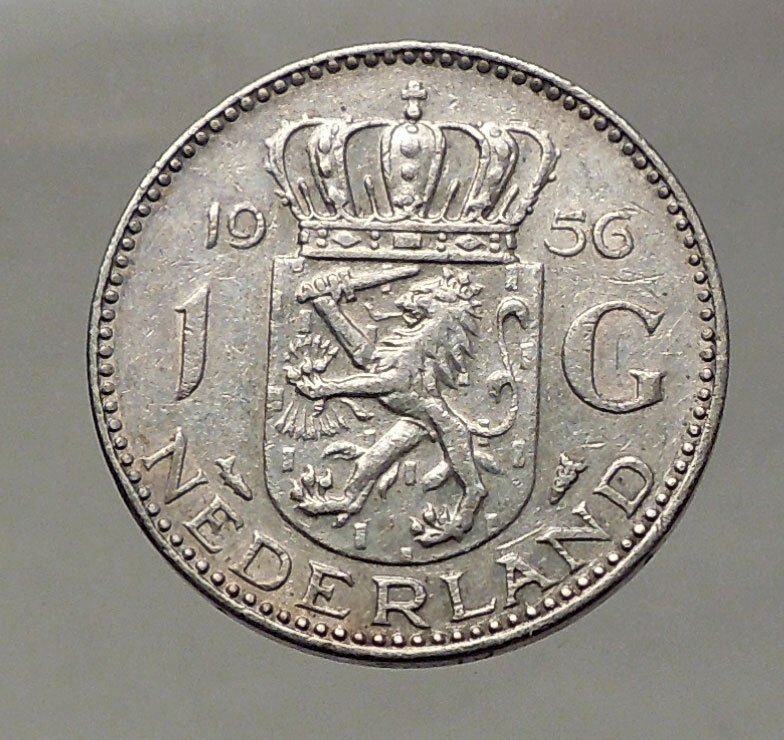|
Netherlands
Juliana – Queen of the Netherlands: 6 September 1948 – 30 April 1980
1962 Silver 2½ Gulden 33mm (15.00 grams) 0.720 Silver (0.345 oz. ASW)
Reference: KM# 185 Designer: L.O. Wenckebach
◦ JULIANA KONINGIN DER NEDERLANDEN, Head of
Queen Juliana right.
1962 2½ G NEDERLAND around coat of arms of Netheralnds.
Edge Lettering: GOD * ZIJ * MET * ONS *
You are bidding on the exact item pictured,
provided with a Certificate of Authenticity and Lifetime Guarantee of
Authenticity.
Click here to see
available for sale in my storeall coins of Netherlands

The
Kingdom of
the Netherlands, commonly known as the Netherlands, is a
sovereign state
and
constitutional monarchy
with territory in
western Europe
and in the
Caribbean
.

The
four parts of the Kingdom –
Aruba
,
Curaçao
,
Sint Maarten
and the
Netherlands
– are constituent
countries
(landen in
Dutch
) and participate on a basis of equality
as partners in the Kingdom. In practice, however, most of the Kingdom affairs
are administered by the Netherlands – which comprises roughly 98% of the
Kingdom’s land area and population – on behalf of the entire Kingdom.
Consequently, the countries of Aruba, Curaçao, and Sint Maarten are dependent on
the Netherlands for matters like
foreign policy
and
defence
, although they are autonomous to a
certain degree with their own
parliaments
.
The vast majority in land area of the constituent country of the Netherlands
(as well as the Kingdom) is located in Europe, with the exception of the
Caribbean Netherlands
: its three special
municipalities (Bonaire,
Saba, and
Sint Eustatius
) that are located in the
Caribbean. The constituent countries of Aruba, Curaçao, and Sint Maarten are
located in the Caribbean as well.

Juliana
(Juliana Louise Emma
Marie Wilhelmina; 30 April 1909 – 20 March 2004) was
Queen
of the
Netherlands
from 1948 until 1980. She reigned
for nearly 32 years. Her reign saw the
decolonization
of both
Indonesia
(Dutch
East Indies) and
Suriname
from the
Kingdom of the Netherlands
.
Upon her death at the age of 94, she was the longest-lived former reigning
monarch in the world.
Early life and
education
Princess Juliana and Queen Wilhelmina in 1914.
Princess Juliana in 1916.
Princess Emma and Princess Juliana in 1920.
Princess Juliana and Prince Bernhard celebrate their engagement in
Amsterdam
on 8 September 1936.
Princess Juliana and Prince Bernhard with their oldest daughters
Princess Beatrix
and
Princess Irene
in
Ottawa
on 4 May 1942.
Prince Bernhard and Queen Juliana with President of the United
States
Harry S. Truman
and First Lady
Bess Truman
at
Washington National Airport
on 2
April 1952.
Queen Juliana and Prince Bernhard at
Soestdijk Palace
on 30 April 1960.
Queen Juliana and King
Baudouin of Belgium
at the
Plantin-Moretus Museum
on 31 May
1960.
Queen Juliana on riding a
bicycle
on
Terschelling
on 11 July 1967.
Prince Bernhard and Queen Juliana with President of Indonesia
Suharto
and First Lady
Siti Hartinah
at
Soestdijk Palace
during a state
visit on 3 September 1970.
Queen Juliana and Prince Bernhard returning from
Porto Ercole
,
Italy
due to developments in the
Lockheed scandal on 26 August 1976.
Queen Juliana at
Soestdijk Palace
on 29 June 1978.
Princess Juliana and Prince Bernhard at
Soestdijk Palace
on 31 May 1980.
Princess Juliana and
Liv Ullmann
at the
Four Freedoms Award
ceremony in
Middelburg
on 23 June 1984.
Juliana was born in
The Hague
on 30 April 1909, the only daughter
of
Queen Wilhelmina of the Netherlands
and
Prince Henry, Duke of Mecklenburg-Schwerin
. She
was the first Dutch royal baby since Wilhelmina herself was born in 1880.
Wilhelmina had suffered four miscarriages and one stillbirth, raising the
prospect that the
House of Orange-Nassau
would die with her. In
all likelihood, this would have meant that the Dutch throne would have passed to
Prince Heinrich XXXII Reuss of Köstritz
, who
had very close ties to
Germany
. Juliana’s birth thus assured the royal
family’s survival. Her mother suffered two further miscarriages after her birth,
leaving Juliana as the royal couple’s only child.
Juliana spent her childhood at
Het Loo Palace
in
Apeldoorn
, and at
Noordeinde Palace
and
Huis ten Bosch
Palace in The Hague. A small
school class was formed at Noordeinde Palace on the advice of the educator
Jan Ligthart
so that, from the age of six, the
Princess could receive her primary education with children of her own age. These
children were
Baroness Elise Bentinck
,
Baroness Elisabeth van Hardenbroek
and
Jonkvrouwe
Miek (Mary) de Jonge
.
As the Dutch constitution specified that Princess Juliana should be ready to
succeed to the throne by the age of eighteen, her education proceeded at a
faster pace than that of most children. After five years of primary education,
the Princess received her secondary education (to pre-university level) from
private tutors.
On 30 April 1927, Princess Juliana celebrated her eighteenth birthday. Under
the constitution, she had officially come of age and was entitled to assume the
royal prerogative, if necessary. Two days later her mother installed her in the
“Raad van State” (“Council of State”).
In the same year, the Princess enrolled as a student at the
University of Leiden
. In her first years at
university, she attended lectures in
sociology
,
jurisprudence
,
economics
,
history of religion
, parliamentary history, and
constitutional law
. In the course of her
studies she also attended lectures on the cultures of
Suriname
and the
Netherlands Antilles
,
international affairs
,
international law
, history, and
European law
. She graduated from the university
in 1930 with a
bachelor’s degree
in international law.
Marriage
In the 1930s, Queen Wilhelmina began a search for a suitable husband for her
daughter. At the time, the
House of Orange
was one of the most strictly
religious royal families in the world, and it was very difficult to find a
Protestant
prince who suited their standards.
Princes from the
United Kingdom
and
Sweden
were “vetted” but either declined or
were rejected by the princess.
At the
1936 Winter Olympics
in
Bavaria
, she met
Prince Bernhard of Lippe-Biesterfeld
, a young
German
aristocrat. Prince Bernhard was a suave
young businessman, and though not a playboy, certainly a “man about town” with a
dashing lifestyle. But his rank and religion were suitable, and so Princess
Juliana’s royal engagement was arranged by her mother. Princess Juliana fell
deeply in love with her fiancé, a love that was to last a lifetime and that
withstood separation during the war and Bernhard’s many extramarital affairs and
illegitimate children. The astute Queen Wilhelmina, by then the richest woman in
the world, left nothing to chance. Wilhelmina had her lawyers draw up a
prenuptial agreement
that specified exactly
what the German-born prince could and could not do, and what money he would
receive from the royal estate. The couple’s engagement was announced on 8
September 1936.
The wedding announcement divided a country that mistrusted Germany under
Adolf Hitler
. Prior to the wedding, on 24
November 1936, Prince Bernhard was granted Dutch
citizenship
and changed the spelling of his
names from German to Dutch. They married in
The Hague
on 7 January 1937, the date on which
Princess Juliana’s grandparents,
King William III
and
Queen Emma
, had married fifty-eight years
earlier. The
civil ceremony
was held in The Hague Town Hall
and the marriage was blessed in the Great Church (St. Jacobskerk), likewise in
The Hague. The young couple moved into
Soestdijk Palace
in
Baarn
.
Their first child,
Princess Beatrix
, was born on 31 January 1938,
and their second,
Princess Irene
, on 5 August 1939.
Canadian exile
On 12 May 1940, during the
invasion of the Netherlands
by Germany in
World War II
, Prince Bernhard and Princess
Juliana were evacuated to the
United Kingdom
to be followed the following day
by the Queen Wilhelmina and the Dutch Government, who set up a
government in exile
. The princess remained
there for a month before taking the children to
Ottawa
, the capital of
Canada
, where she resided at
Stornoway
in the
suburb
of
Rockcliffe Park
. Her mother and husband
remained in Britain with the
Dutch government-in-exile
.
When her third child,
Princess Margriet
, was born, the
Governor General of Canada
,
Alexander Cambridge, Earl of Athlone
, granted
Royal Assent
to a special law declaring
Princess Juliana’s rooms at the
Ottawa Civic Hospital
as
extraterritorial
so that the infant would have
exclusively Dutch, not
dual nationality
. Had these arrangements not
occurred, Princess Margriet would not be in the
line of succession
. The Canadian government
flew the Dutch tricolour flag on parliament’s
Peace Tower
while its
carillon
rang out with Dutch music at the news
of Princess Margriet’s birth. Prince Bernhard, who had remained in
London
with Queen Wilhelmina and members of the
exiled Dutch government, was able to visit his family in Canada and be there for
Margriet’s birth. Princess Juliana’s genuine warmth and the gestures of her
Canadian hosts created a lasting bond which was reinforced when Canadian
soldiers fought and died by the thousands in 1944 and 1945 to liberate the
Netherlands from the
Nazis
. On 2 May 1945 she returned by a military
transport plane with Queen Wilhelmina to the liberated part of the Netherlands,
rushing to Breda
to set up a temporary Dutch government.
Once home she expressed her gratitude to Canada by sending the city of Ottawa
100,000 tulip bulbs. Princess Juliana of the Netherlands erected a Wooden
lectern and brass plaque which is dedicated in thanks to the
St. Andrew’s Presbyterian Church (Ottawa)
for
their hospitality during Princess Juliana’s residence in Ottawa during the
Second World War.
On 24 June 1945, she sailed on the
Queen ElizabethRMS
from Gourock
,
Scotland
, to the
United States
, listing her last permanent
residence as London
,
England
. The following year (1946), Juliana
donated another 20,500 bulbs, with the request that a portion of these be
planted at the grounds of the Ottawa Civic Hospital where she had given birth to
Margriet. At the same time, she promised Ottawa an annual gift of tulips during
her lifetime to show her lasting appreciation for Canada’s war-time hospitality.
Each year Ottawa hosts the
Canadian Tulip Festival
in celebration of this
gift.
On 2 August 1945, Princess Juliana was reunited with her family on Dutch
soil. Juliana immediately took part in a post-war relief operation for the
people in the northern part of the country, where the Nazi-caused famine (the
famine winter of 1944–1945) and their continued torturing and murdering of the
previous winter had claimed many victims. She was very active as the president
of the
Dutch Red Cross
and worked closely with the
National Reconstruction organization. Her down-to-earth manner endeared her to
her people so much that a majority of the Dutch people would soon want Queen
Wilhelmina to abdicate in favour of her daughter. In the spring of 1946 Princess
Juliana and Prince Bernhard visited the countries that had helped the
Netherlands during the occupation.
During her pregnancy with her last child,
Marijke Christina
, Princess Juliana contracted
German measles
. The girl was born in 1947 with
cataracts
in both eyes and was soon diagnosed
as almost totally blind in one eye and severely limited in the other. Despite
her blindness, Christina, as she was called, was a happy and gifted child with a
talent for languages and an ear for music. Over time, and with advances in
medical technology, her eyesight did improve such that with thick glasses, she
could attend school and even ride a bicycle. However, before that happened, her
mother, the Princess, clinging to any thread that offered some hope for a cure,
came under the strong influence of
Greet Hofmans
, a
faith healer
with
heterodox
beliefs, who was considered by “her
many detractors” to be a sham.
Reign
Wilhelmina’s increasingly precarious health made it increasingly difficult
for her to perform her duties. Juliana was forced to take over as
regent
from 14 October to 1 December 1947.
Wilhelmina seriously considered abdicating in favour of Juliana at the end of
1947, but Juliana urged her mother to stay on the throne so she could celebrate
her
diamond jubilee
. However, Wilhelmina was forced
to relinquish her royal duties to Juliana once again on 4 May 1948.
The independence of
Indonesia
, which saw more than 150,000 Dutch
troops stationed there as
decolonization
force, was regarded as an
economic disaster for the Netherlands. With the certain loss of the prized
colony, the queen announced her intention to abdicate, doing so on 4 September
1948. Two days later, with the eyes of the world upon her, Juliana was
inaugurated in the
Nieuwe Kerk
in
Amsterdam
, becoming the 12th member of the
House of Orange to rule the Netherlands.
On 27 December 1949 at
Dam Palace
in Amsterdam, Queen Juliana signed
the papers that recognised Indonesian sovereignty over the former
Dutch colony
. She became Hoofd der Unie
(Head of the Union) of the
Netherlands-Indonesian Union
(1949-1956). On 15
December 1954, the Queen announced that the nation’s
Caribbean
possessions of the
Netherlands Antilles
and
Suriname
were to be reconstituted as
constituent countries
of the Kingdom of the
Netherlands, making them equal partners with the mainland.
Her daughter’s blindness and the increasing influence of Hofmans, who had
moved into a royal palace, severely affected the queen’s marital relationship.
Over the next few years, the controversy surrounding the faith healer, at first
kept out of the Dutch media, erupted into a national debate over the competency
of the queen. However, the debate subsided in part due to Juliana’s efforts to
connect with her people. She often appeared in public dressed like any ordinary
Dutch woman, and preferred to be addressed as “Mevrouw”
(Dutch for “Mrs.”) rather than her formal title of ‘majesty’. She also began
riding a bicycle for exercise and fresh air.
Although the bicycle and the down-to-earth manners suggest a simple life
style, the Dutch royal court of the 1950s and 1960s was still a splendid affair
with chamberlains in magnificent uniforms, gilded state coaches, visits to towns
in open carriages and lavish entertaining in the huge palaces. At the same time
the queen began visiting the citizens of the nearby towns and, unannounced,
would drop in on social institutions and schools. Her refreshingly
straightforward manner and talk made her a powerful public speaker. On the
international stage, Queen Juliana was particularly interested in the problems
of developing countries, the refugee problem, and had a very special interest in
child welfare, particularly in the developing countries.
On the night of 31 January 1953, the Netherlands was hit by
the most destructive storm in more than five hundred years
.
Thirty breaches of dunes and dikes occurred and many towns were swept away by
twelve-foot tidal waves. More than two thousand people drowned and tens of
thousands were trapped by the floodwaters. Dressed in boots and an old coat,
Queen Juliana waded through water and slopped through deep mud all over the
devastated areas to bring desperate people food and clothing. Showing compassion
and concern, reassuring the people, her tireless efforts would permanently
endear her to the citizens of the Netherlands.
In 1956, the influence of Miss Hofmans on Juliana’s political views almost
brought down the monarchy in a
constitutional crisis
that caused the court and
the royal family to split into a “Bernhard faction” set on removing a queen
considered a religious fanatic and a threat to
NATO
, and the queen’s pious and
pacifist
courtiers. Prime Minister
Willem Drees
resolved the crisis. However,
Juliana lost out to her powerful husband and his friends. Hofmans was banished
from the court and Juliana’s supporters were sacked or pensioned. Prince
Bernhard planned to divorce his wife but decided against it when he, as he told
an American journalist, “found out that the woman still loved him”.
In 1963 Queen Juliana faced another crisis among her Protestant citizens when
her second daughter
Irene
secretly converted to
Roman Catholicism
and, without government
approval, on 29 April 1964 married
Prince Carlos Hugo
of
Bourbon
,
Duke of Parma
, a claimant to the Spanish throne
and also a leader in Spain’s
Carlist
party. With memories of the Dutch
struggle for independence from Roman Catholic Spain and fascist German
oppression still fresh in the minds of the Dutch people, the events leading to
the marriage were played out in all the newspapers and a storm of hostility
erupted against the monarchy for allowing it to happen—a matter so serious that
the queen’s abdication became a real possibility. She survived, however, thanks
to the underlying devotion she had earned over the years.
Another crisis developed as a result of the announcement in July 1965 of the
engagement of Princess Beatrix, heir to the throne, to German diplomat
Claus von Amsberg
. The future husband of the
future queen had been a member of the
Nazi
Wehrmacht
and the
Hitler Youth
movement. Many angry Dutch
citizens demonstrated in the streets, and held rallies and marches against the
“traitorous” affair. While this time there were no calls for the queen’s
abdication because the true object of the people’s wrath, Princess Beatrix,
would then be queen, they did start to question the value of having a monarchy
at all. After attempting to have the marriage cancelled, Queen Juliana
acquiesced and the marriage took place under a continued storm of protest and an
almost certain attitude pervaded the country that Princess Beatrix might be the
last member of the House of Orange to ever reign in the Netherlands. Despite all
these difficulties, Queen Juliana’s personal popularity suffered only
temporarily.
The queen was noted for her courtesy and kindness. In May 1959, for example,
Polish-American
ufologist
George Adamski
received a letter from the lady
head of the Dutch Unidentified Flying Objects Society informing him that she had
been contacted by Queen Juliana’s palace and “that the Queen would like to
receive you.” Adamski informed a London newspaper about the invitation, which
prompted the court and cabinet to request that the queen cancel her meeting with
Adamski, but the queen went ahead with the meeting saying that, “A hostess
cannot slam the door in the face of her guests.” After the meeting, Dutch
Aeronautical Association president Cornelis Kolff said, “The Queen showed an
extraordinary interest in the whole subject.” The Dutch press put it more
straightforwardly: According to Time Magazine Amsterdam newspaper De
Volkskrant said: “The Dutch press could hardly be accused of concealing the
facts last week. Once again, Queen Juliana’s weakness for the preternatural had
landed her back in the headlines: she had invited to the palace a crackpot from
California who numbered among his friends men from Mars, Venus and other
solar-system suburbs.”
An event in April 1967, helped by an improving Dutch economy, brought an
overnight revitalization of the royal family when the first male heir to the
Dutch throne in 116 years,
Willem-Alexander
, was born to Princess Beatrix.
This time the demonstrations in the street were of love and enthusiasm.
On 25 November 1975,
Suriname
seceded from the Dutch Kingdom and
became independent. Representing the Queen at the independence ceremony in the
Surinamese capital,
Paramaribo
, were her daughter and heir
presumptive,
Princess Beatrix
, and her husband,
Prince Claus
.
Scandal rocked the royal family again in 1976 when it was revealed that
Prince Bernhard had accepted a
US$
1.1 million bribe from U.S. aircraft
manufacturer
Lockheed Corporation
to influence the Dutch
government’s purchase of fighter aircraft in what became known as the
Lockheed Scandal
.
Prime Minister
Joop den Uyl
ordered an inquiry into the affair
while Prince Bernhard refused to answer reporters’ questions, stating: “I am
above such things.” Rather than calling on the queen to abdicate, the Dutch
people were this time fearful that their beloved Juliana might abdicate out of
shame or because of a criminal prosecution conducted in her name against her
consort.
On 26 August 1976, a censored and toned-down, but devastating report on
Prince Bernhard’s activities was released to a shocked Dutch public. The prince
resigned his various high-profile positions as a
lieutenant admiral
, a general, and an
Inspector General of the Armed Forces
. He
resigned from his positions in the board of many businesses, charities, the
World Wildlife Fund
, and other institutions.
The prince also accepted that he would have to give up wearing his beloved
uniforms. In return, the
States-General
accepted that there was to be no
criminal prosecution.
On her
Silver Jubilee
in 1973, Queen Juliana donated
all of the money that had been raised by the National Silver Jubilee Committee
to organizations for children in need throughout the world. She donated the gift
from the nation which she received on her seventieth birthday to the “International
Year of the Child.” She was the 922nd Lady of the
Order of the Garter
in 1958.
On 30 April 1980, her 71st birthday, Queen Juliana
abdicated
and her eldest daughter succeeded
her. Juliana remained active in numerous charitable causes until well into her
eighties.
Illness and death
From the mid-1990s, Juliana’s health declined and she also suffered the
progressive onset of
dementia
. Juliana did not appear in public
after this time. At the order of the Royal Family’s doctors, Juliana was placed
under 24-hour care. Prince Bernhard said in a television interview in 2001 that
the former Queen was no longer able to recognise her family and that she had
been suffering from
Alzheimer’s disease
for several years.
Juliana died in her sleep on 20 March 2004, several weeks before her 95th
birthday, at
Soestdijk Palace
in Baarn from complications of
pneumonia
, seventy years to the day after her
grandmother,
Queen Emma
. She was
embalmed
, unlike her mother Wilhelmina, who
chose not to be, and on 30 March 2004 interred beside her mother in the royal
vaults under the
Nieuwe Kerk
in
Delft
. The memorial service made her
ecumenical
and often highly personal views on
matters of religion public. The late Princess, a
vicar
said in her sermon, was interested in all
religions and in
reincarnation
. Juliana’s husband Prince
Bernhard died eight months later aged 93, on 1 December 2004; his remains were
placed next to hers.
In 2009 an exhibition of portraits of Juliana, and objects from her life, was
held at the
Het Loo Palace
to mark the centenary of her
birth.
|





.svg/220px-Kingdom_of_the_Netherlands_(orthographic_projection).svg.png)




















